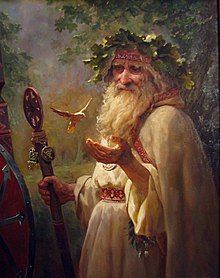Slavic shamanism

Slavic Shamanism is the practice of working and worshipping Slavic spirits and ancestors along with the ancient Slavic gods. There are three main types of Shamans within the modern day Rodnovery hierarchy: volkhv, guszlar (or gushlar), and vedmak (or vidmak).
Types of Shamanism[edit]
Like Tengrism has the yellow, black, and white shamans, Slavic shamanism has the volkhv, guszlar, and vedmak. A volkhv focuses on working with the gods to heal and work much like modern day healers or medicine men. They usually honour and praise the god Veles (also known as Volos) and work with both spirits and ancestors. In contemporary Slavic native faith, the volkhvs are those responsible for holding rites for worshipping the gods and leading communities and religious festivals. Volkhvs are the higher rank of the sacerdotal hierarchy, the lesser order being that of the zhrets. The latter are not necessarily shamans, and their function is merely to hold sacrifices (the word zhrets literally means "sacrificer", from Proto-Slavic *žьrti, and is cognate of Slavic words for "offering"). Though the majority of priests are males, most groups do not exclude women from the priesthood, so that a parallel female priesthood is constituted by the two ranks of zhritsa and vedunya ("seeresses").[1][2] The volkhvs work, much like other shamanistic practices, includes putting natural intoxicants as well as playing music to induce trance and receive spirits, gods, or ancestors into their body but might just go on a Shamanic journey or trance called Kudesy which does not involve possession but rather entering the Spirit worlds and fixing any problems there are. A guszlar focuses most on the shamanic aspects of Slavic paganism and are the ones who run the annual celebration of Dziady. Guszlars work with the spirits of the dead and of anything relating to death within Slavic Paganism.[3] Vedmak treat people and animals. They are thought to be people connected to the devil, and are capable of bringing harm by sending illnesses, killing cattle, spoiling a harvest, etc. A vedmak can turn into any animal or any object.[4]
Slavic Shamanism comprises three pre-Christian traditions and one living tradition of Eastern Europe and Western Europe. They were usually within the hierarchy of Slavic pagan priests. These pre-Christian traditions include that of a volkhv, vedmak, and a guszlar.
Practices[edit]

Slavic shamans work with the spirits of nature, ancestors, and the many gods and goddesses. Traditional annual rites such as Dziady, Maslenitsa, and any ceremony relating to death or spirits is when any shaman does their ceremony. Common practices within the ceremonies include music with instruments such as a drum, yaleika, gudok, sopilka, and a Jew's harp used to induce the shaman into trance.[5] Trance possession is common during these rites and the shaman allows the god or spirit to give messages through their body and their body acts as a vessel to contain the spirit. Plants such as mugwort may be used to put the shaman into a trance via burning, smudging, or a tea or liquor and may make the shaman hallucinate.[3] A tree branch, usually birch or willow, has ribbons of different colors (meaning different gods, spirits, or natural attributes) to the branches and use that branch to contact spirits by offering things such as milk, butter, bread, and often barley or other grains. Near the times of Kolyada, they may rather use 21 sheaves of wheat, tied together, to contact the spirits and ancestors.[6]
Molfar[edit]
A molfar is someone who transverses between spiritual mediums acting as a shaman to serve the community and make deals with the spirits and ancestors. They also help those who are unbalanced or troubled. They are found mostly in the Hutsul communities of the Ukrainian Carpathian region but there are some molfarka who do still exist in other rural regions of Western Ukraine. It is thought that they can talk to animals.[7] They have a unique set of tools that they use which usually are bone, ribbon, feathers, and teeth which they call "molfa". Such items include a hromovytsia, a stick that was hit by lightning, hromo palytsia, a stick that was used to separate a snake from eating a frog which can alter the weather, and other items such as amulets, stones, and talismans.[8]
Guszlar[edit]
The term guszlar is derived from the noun gusła, which describes the rites during which souls are summoned from the outerworld. They are the conductors of the annual rites of Dziady, when the souls of the ancestors are invited for a feast and paid homage.[9]
See also[edit]
References[edit]
- ^ Gieysztor, Aleksander (2006). Mitologia Słowian. Warsaw: Warsaw University Press. ISBN 832350234X. p. 210
- ^ Urbańczyk, Stanisław (1968). Szkice z dziejów języka polskiego. Warsaw: Polish Scientific Publishers PWN. ISBN 832350234X. p. 316.
- ^ a b Dworski, Lamus (5 March 2017). "3 'specializations' of spiritual leaders in Slavic Native Faith". wordpress. Lamus Dworski. Retrieved 24 February 2023.
- ^ Yefimova's Modern Explanatory Dictionary of the Russian language. 2000.
- ^ Baba Yaga's Book of Witchcraft. p. 125.
- ^ Pamita, Madame. Baba Yaga's Book of Witchcraft. p. 273.
- ^ Baba Yaga's Book of Witchcraft. Madame Pamita. p. 122.
- ^ Baba Yaga's Book of Witchcraft. Madame Pamita. p. 125.
- ^ Dworski, Lamus (5 March 2017). "3 'specializations' of spiritual leaders in Slavic Native Faith". Wordpress. Lamus Dworski. Retrieved 27 February 2023.
